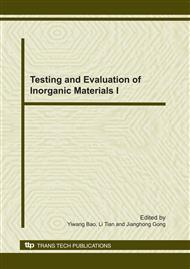p.272
p.277
p.281
p.284
p.287
p.293
p.298
p.302
p.306
Structural and Optical Properties of 6H-SiC Helium and Oxygen Implanted at 700 K
Abstract:
Raman scattering spectroscopy, ultraviolet and visible absorption spectroscopy and Rutherford backscattering spectrometry were employed to analyze the annealing behavior of defects and the optimistic effect of cavities to oxygen. It was found that the cavities had strong getting effect to oxygen and captured its neighboring implanted oxygen atom, and enhanced the formation of SixOy compound, thus helped shaping the buried oxide in a well defined region. In addition, it also minished the damage level in lattice. The interface between damage layer and crystalline layer was estimated to be 198 nm below surface of 6H-SiC. The implanted oxygen was pegged in the compressed and serried cavity layer, making the amorphous layer narrower than that of reference samples
Info:
Periodical:
Pages:
287-292
Citation:
Online since:
December 2010
Authors:
Price:
Сopyright:
© 2011 Trans Tech Publications Ltd. All Rights Reserved
Share:
Citation:


